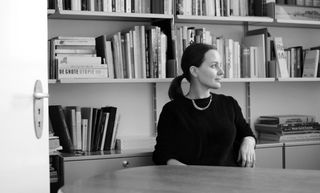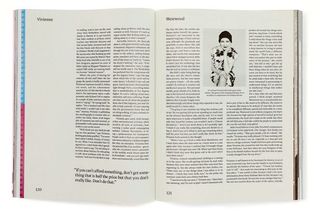Veronica Ditting on the importance of editorial design
The art director of Fantastic Man and The Gentlewoman explains why her editorial design experience informs all her other design work.
Veronica Ditting is an award-winning independent graphic designer and art director. She was born in Buenos Aires, Argentina, grew up in Germany and is currently working in Amsterdam and London. Here she explains how her editorial design experience informs all her design work.
How much do magazines influence your more corporate client work?
Using an editorial design approach is key to all projects I work on, whether it's a magazine, a book, a website or a visual identity. The process might be a bit different with each project, but I always take a very editorial approach, motivated by content.

Where does your fascination with editorial design stem from?
Studying at the Gerrit Rietveld Academy in Amsterdam definitely influenced me. It was never about the client, but about what part you can play in the project. The term 'client' was actually a big taboo: the preferred term was 'collaborator'. After graduating, this approach became an integral part of my practice.
Can a designer ever replicate the best magazines' strong editor-art director relationship with a client?
Regardless of how big or small the team, as a designer it's about the dialogue you have with your collaborators: editor, photographers, writers – or client. If you feel like someone you're working with doesn't have the same standards or different taste levels as you, you'll have a tough time making it work.
During the first meeting for a potential new project, I make sure clients understand my way of working. Often designers are just given a piece of text and asked to lay it out. For us, it's about dialogue. Design and editorial influence each other until the very end.

This kind of interplay between design and content is crucial in great editorial design. Does corporate work present more of a challenge here?
Sometimes clients aren't used to working with a designer, or even with a writer. There can be different ideas of what material is acceptable to use. It has definitely happened in the past that a client has supplied poorly written text and unusable images, and I've had to come up with other solutions.
I'd find it rather dull to have to provide only a visual solution to a problem: for example, receiving all the assets for a project without discussing them. In my experience, people are often relieved when someone offers them an outside perspective.
Words: Jeremy Leslie
This article originally appeared in Computer Arts issue 229.

Thank you for reading 5 articles this month* Join now for unlimited access
Enjoy your first month for just £1 / $1 / €1
*Read 5 free articles per month without a subscription

Join now for unlimited access
Try first month for just £1 / $1 / €1
Get the Creative Bloq Newsletter
Daily design news, reviews, how-tos and more, as picked by the editors.
The Creative Bloq team is made up of a group of design fans, and has changed and evolved since Creative Bloq began back in 2012. The current website team consists of eight full-time members of staff: Editor Georgia Coggan, Deputy Editor Rosie Hilder, Ecommerce Editor Beren Neale, Senior News Editor Daniel Piper, Editor, Digital Art and 3D Ian Dean, Tech Reviews Editor Erlingur Einarsson and Ecommerce Writer Beth Nicholls and Staff Writer Natalie Fear, as well as a roster of freelancers from around the world. The 3D World and ImagineFX magazine teams also pitch in, ensuring that content from 3D World and ImagineFX is represented on Creative Bloq.
